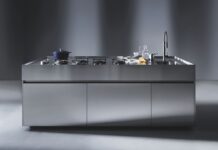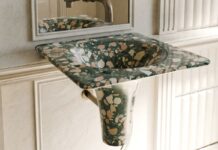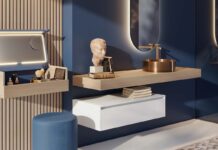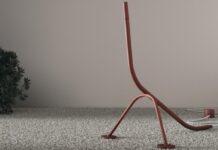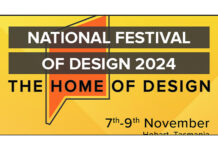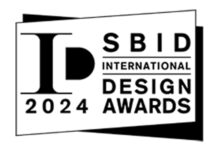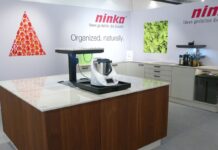At the recent Good Design Awards, the Halo sink, by UNSW Honours student Liam Lo Cascio, was awarded a Best in Class award in the Next Gen category.
TKBB spoke to Liam about the award and about his inspiration for this incredible design. “This was my Honours project for Industrial Design at the University of New South Wales,” he explains. “When trying to decide on a project topic, we’re often encouraged to look for new and unique ways to make life easier for people. My grandfather had suffered a stroke around five years prior so his experience was fresh in my mind”.
 Liam saw first-hand the way his grandfather’s life changed after his stroke and noticed how he was unable to easily take on everyday tasks. In his grandfather’s case, the stroke affected his eyesight but in Liam’s own words “it started the cogs turning” and he decided to research and interview a number of stroke survivors to find out more about their experience.
Liam saw first-hand the way his grandfather’s life changed after his stroke and noticed how he was unable to easily take on everyday tasks. In his grandfather’s case, the stroke affected his eyesight but in Liam’s own words “it started the cogs turning” and he decided to research and interview a number of stroke survivors to find out more about their experience.
The end result is the Halo sink. Halo is a sink designed to allow individuals with hemiparesis to safely and easily clean kitchen cookware and cutlery one-handed.
 Liam’s research revealed that one in four people are expected to suffer a stroke in their lifetime and, of those, 40-50% are expected to experience long-lasting upper extremity impairment.
Liam’s research revealed that one in four people are expected to suffer a stroke in their lifetime and, of those, 40-50% are expected to experience long-lasting upper extremity impairment.
“This can lead to difficulty performing everyday tasks, such as washing up after cooking,” explains Liam. “The current assistive hand-dishwashing market is limited, with individuals opting to develop their own one-handed cleaning techniques or makeshift devices”.
Additionally, he discovered that many assistive products lack aesthetic qualities, with a focus solely on functionality and this, Liam says, can contribute to creating a stigma around their use and ownership. “The design challenge was to create a more functional, aesthetically-pleasing and assistive kitchen sink that allows stroke survivors to easily and safely clean one-handed,” he adds.
 Utilising integrated steps, Halo can grip pots, pans, plates and bowls, allowing the user to scrub effectively with their more able side. With its taper design, the sink accommodates variations in pot and pan sizes from 140mm to 300mm, as well as plates and bowls, ensuring all cookware can be gripped for easy cleaning. The taper design was conceptualised during user testing and rounded out the sink’s functionality. The pot tipper adds additional functionality to the sink, allowing stroke survivors to safely pour water from pots into the sink, where they may struggle otherwise.
Utilising integrated steps, Halo can grip pots, pans, plates and bowls, allowing the user to scrub effectively with their more able side. With its taper design, the sink accommodates variations in pot and pan sizes from 140mm to 300mm, as well as plates and bowls, ensuring all cookware can be gripped for easy cleaning. The taper design was conceptualised during user testing and rounded out the sink’s functionality. The pot tipper adds additional functionality to the sink, allowing stroke survivors to safely pour water from pots into the sink, where they may struggle otherwise.
Liam says the design process wasn’t quite the linear path that some might assume. “I started off wanting to make some sort of glove that would stimulate the nerves in the hand to help it open and close,” he laughs. “But I quickly realised that I could not achieve that in the year that I had. So, I needed to pivot and focus on just one activity”.
Liam’s research encompassed talking to stroke survivors as well as occupational therapists and additional investigation to collate as much advice and information as possible. “I realised I couldn’t make assumptions without talking to the survivors and finding out what they needed and hearing from them what would work for their circumstances,” he says. Liam also became immersed in the world of Australian Standards and regulations around sink installation and manufacture.
 “I wanted to make sure it would be wheelchair accessible so I made it slightly shallower than a traditional sink to allow space for the chair underneath,” Liam says. “And I designed it to fit an existing cut-out so the benchtop wouldn’t need to be replaced. I also looked into NDIS requirements to make sure that Halo was suitable”.
“I wanted to make sure it would be wheelchair accessible so I made it slightly shallower than a traditional sink to allow space for the chair underneath,” Liam says. “And I designed it to fit an existing cut-out so the benchtop wouldn’t need to be replaced. I also looked into NDIS requirements to make sure that Halo was suitable”.
Liam says the biggest challenge was functionally getting the sink to work. While his own pots and pans from home were a set size, he was aware of the wide range and variety of cookware available so his motivation was to come up with a solution that was flexible enough to accommodate all options.
“Before I found the step design there was nothing that would do what I wanted it to do,” he recalls. “I started with flexible walls but they weren’t strong enough – the user needed the full strength of their arm to lock the item in place so that was no good.
“But, once I found the solution I felt as though it was so simple,” he laughs.
 Halo’s major benefit is in the improvements to self-worth and quality of life for stroke survivors as it fosters increased independence and helps to avoid feelings of burden. Liam feels this will contribute to improved relationships in households with stroke survivors as they are able to become more independent and less reliant on those around them.
Halo’s major benefit is in the improvements to self-worth and quality of life for stroke survivors as it fosters increased independence and helps to avoid feelings of burden. Liam feels this will contribute to improved relationships in households with stroke survivors as they are able to become more independent and less reliant on those around them.
He is particularly proud of the modern aesthetic of the Halo sink as its design makes a visual statement that makes the sink more covetable for a modern home.
Halo is constructed in stainless steel for its longevity and resilience. “Maybe it would have been easier to manufacture in plastic but it wouldn’t have been as durable,” says Liam. “I didn’t want the connotation of a lower quality product and I was super conscious of sustainability; the sink can be fully recycled at the end of its lifecycle”.
 TKBB asked Liam about his design process, and whether he prefers to start with the problem or the solution, or somewhere in between. “I think it’s different for each project but, in this case, I started with the problem and then I came up with three or four ideas that might solve the problem,” he says. “I then took my solutions to a stroke survivor and had them test them for me. The stepped design was the favourite so I took that and developed it further”.
TKBB asked Liam about his design process, and whether he prefers to start with the problem or the solution, or somewhere in between. “I think it’s different for each project but, in this case, I started with the problem and then I came up with three or four ideas that might solve the problem,” he says. “I then took my solutions to a stroke survivor and had them test them for me. The stepped design was the favourite so I took that and developed it further”.
For a newly-graduated designer, this is a significant award so TKBB asked Liam what it mean to him and how he saw it changing the trajectory of his career. “This award is amazing and I’m very honoured to receive it. Winning an award like this one can change the potential of my career,” he says.
Liam says there were many stages during the design when he doubted his decisions and worried that he had chosen the wrong product, or received feedback that wasn’t what he had hoped for. But this award proves that staying firm in his belief paid off. “My advice to any young designer is: if you have an idea you feel is strong enough then trust your gut and stick with it to see where it goes,” he says. “Don’t give up!”
As for what’s next for Liam, he proudly tells us he has secured a position with a commercial furniture manufacturer and plans to spend some time honing his design skills and working in the “real world”. He will take a break from study for now but hasn’t ruled out a PHD in the future. His dream for the future is to work in disability design, and even maybe establish his own company. “I see so much potential for design solutions that are functional as well as aesthetically pleasing and I don’t think products designed for those with disabilities should sacrifice great aesthetics so I’d love to explore that further,” he says.
For more information visit https://www.liamlocascio.com/



